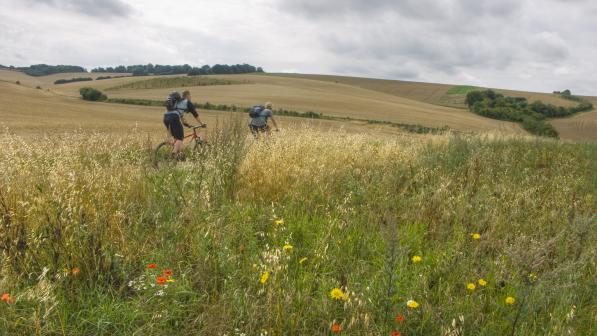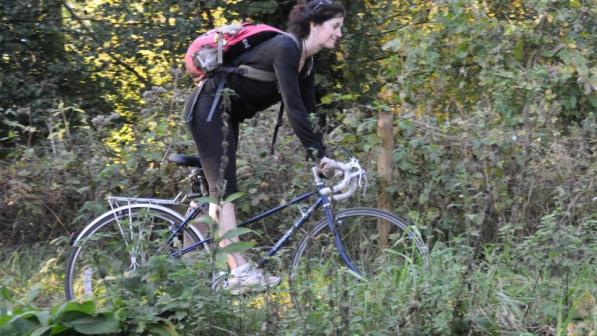Mending the damage of Beeching's axe: cycling threat or opportunity?

As rail enthusiast and journalist Simon Jenkins explained in the Guardian, back in the 1960s Richard Beeching was tasked by the Prime Minister of the day, Harold MacMillan, to “run the railways as a profitable business”. Half of the stations raised just 2 percent of British Rail’s revenue, and a third of the network only carried 1 percent of passengers. Beeching’s solution was to close 5,000 miles of railway.
Ever since then, Beeching and his axe have been vilified in British transport history, though the real culprit for closure was potentially a different mode of travel rather than one individual. “It was the motor car,” writes Jenkins, “Not Beeching, that butchered the railway – more services were closed between the 1920s and 1950s than by him."
Therefore the government’s latest announcement places Cycling UK in a bit of a dilemma.
On the one hand, any measure which helps reduce traffic volume and gives people a more sustainable alternative to the motor car is always to be applauded.
On the other, there is the concern about what this could mean for some of the UK’s iconic traffic free cycle routes, like the link between Bath and Bristol, the Monsal Trail or parts of the Sea to Sea (C2C) – all of which are built (at least in part) on old disused railways. Cycling and walking is allowed on many of these routes thanks to “permissive access”, which grants access to a piece of land by permission of the landowner rather than as a public right which places them at greater risk, than if they were a recognised right of way (eg footpath or bridleway).
It’s at this point, I should probably declare a bit of a personal interest in this announcement. Earlier this year, my partner and I finally managed to save enough for a house, and chose specifically one which had the Downslink, built upon the old Guildford to Brighton line, running past the bottom of our garden.
Whilst a busy road rushes and buzzes past the front of our home, out back there is a tranquil green highway that allows us to cycle five out of the six miles to our respective places of work in the peace and quiet which comes with a car free route. The thought of losing this and having to battle my way with other traffic, apart from the occasional dog walker or horse rider, is not attractive.
Fortunately, both Cycling UK and Sustrans share my concerns – if from a more altruistic position.
While Cycling UK doesn’t want existing cycle and walking routes to derail future plans that might see rural communities better connected, we do believe that these traffic free routes shouldn't be put at risk either.
Sam Jones, Cycling UK
Commenting on the announcement, Xavier Brice, Sustrans CEO said: “These routes, some of which form the National Cycle Network, are a critical part of the country's active travel infrastructure and strategy, encouraging people to walk and cycle in a safe environment, as well as providing important commuting access for people choosing to travel actively to work.”
While Cycling UK doesn’t want existing cycle and walking routes to derail future plans that might see rural communities better connected, we do believe that these traffic free routes shouldn't be put at risk either.
It’s important when any decisions are made about reopening up old railway tracks to take into account the benefit they might be making to the local economy, through its attraction to people cycling and walking. A good example of this is the popularity of the old line between Penrith and Keswick in the Lake District.
As part of the Sea to Sea route, which in itself is the UK’s busiest challenge ride with an average of 15,000 people riding it’s length, the 20-mile route from Penrith to Keswick is truly beautiful, as it follows the old railway line and the river Greta. However after flooding in February 2016 washed away two bridges and seriously damaged a third, access has been severely limited.
When Cycling UK’s Roger Geffen visited Keswick in spring this year he was shocked to learn of the impact on the local economy. Keswick’s previously thriving cycle shop was feeling the pinch brought upon a decline in people visiting the area and wishing to hire bikes, while once popular tea shops along the route itself were also suffering.
Thankfully for people visiting this beauty spot, the government has not given any indication that it is looking at this particular bit of track, but we fully support Mr Brice’s point how “It will be critical that the many walking and cycling routes which have been built along some of these lines are also maintained”, while also welcoming the potential for the re-opening of disused railway lines.
However, Cycling UK believes it shouldn’t be enough simply to maintain existing cycling and walking routes, but where the Government is looking to reintroduce railway lines in these locations, we would like to see these routes improved too.
Of course, not every old railway line which is reopened has been turned into a cycling or walking route. In these situations, we want the Government and local authorities to see the opportunity of opening new cycle routes near to, and just as importantly across, the new railway lines.
By this we don’t necessarily mean having a cycle lane running exactly alongside a train line – that would be undoubtedly be an unpleasant, if not a slightly dangerous experience! However there is the opportunity to plan a network that would give people the opportunity to cycle in safety to the station or ensure that large detours on busy roads are not necessary by providing suitable crossing points.
This is not a farfetched idea by any stretch, and is more commonly referred to in campaigning parlance as “cycle-proofing”. The Department for Transport is already committed to this concept when it builds new motorways or trunk roads. For Cycling UK to give its full support to the re-opening of old railways, we want definite confirmation that the principles of cycle-proofing will also be applied in this context as well.
The government has confirmed it is already planning to reopen the railway line from Oxford to Cambridge, and its new development programme will look to identify new connections and lines, as part of finding and funding future rail schemes which offer good value.
Ultimately, this decision should be regarded as good news, but perhaps now is also the time to begin considering making some of our beloved green highways built on disused railways dedicated rights of way, if we wish to secure their future for the next generation and beyond.


